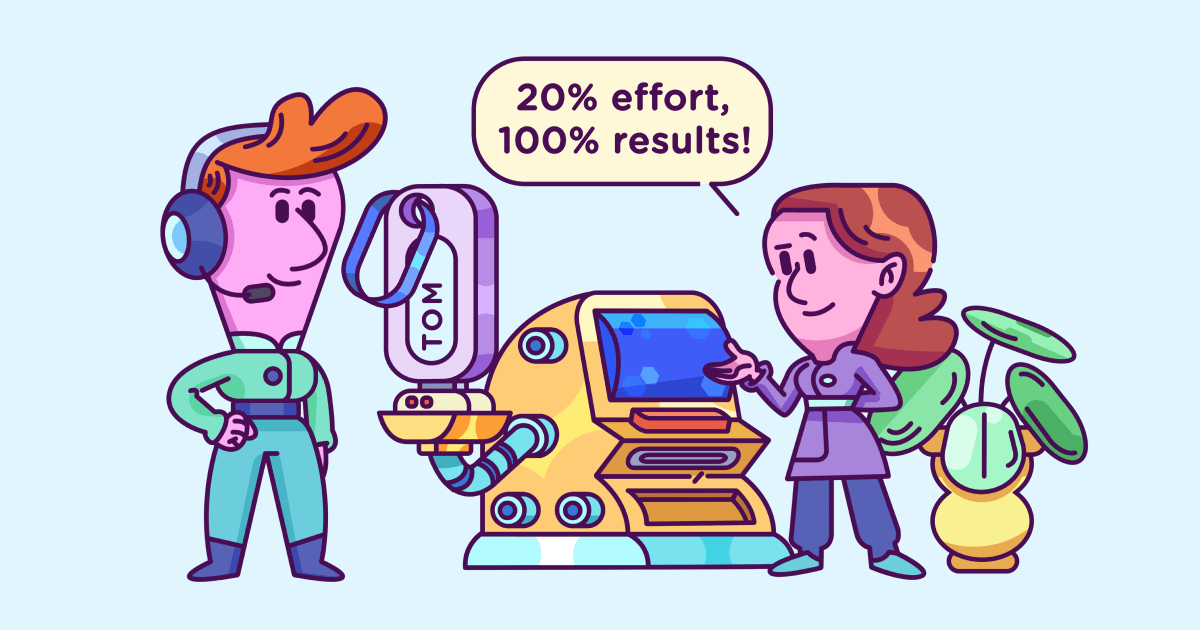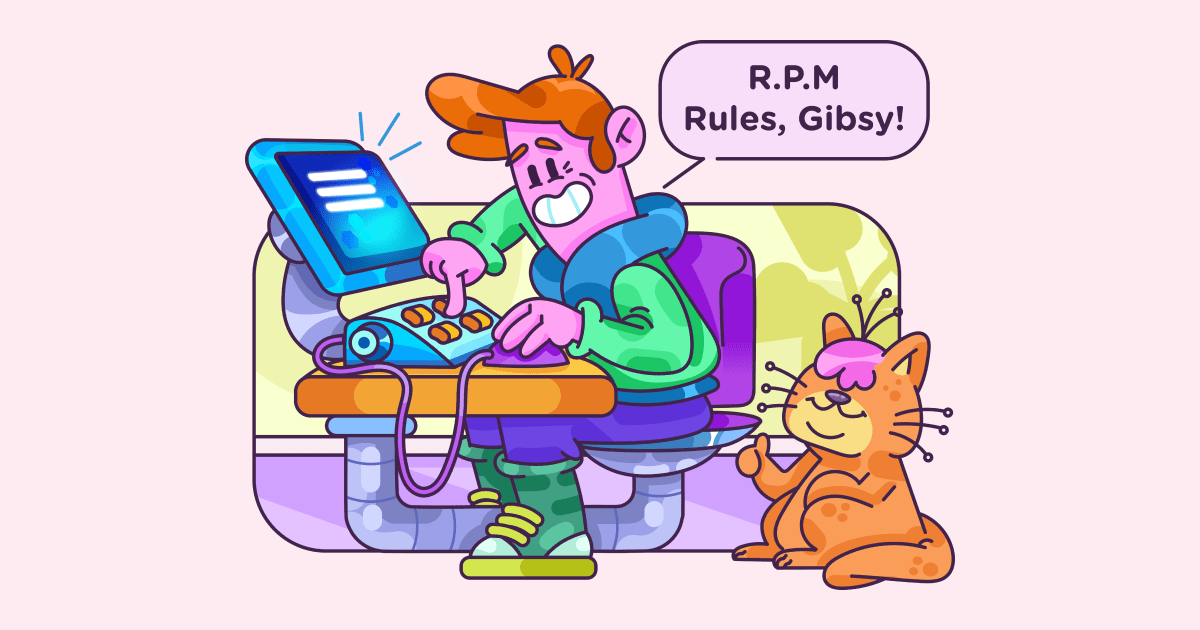A guide to time mapping (+ time mapping template)
Last updated on: December 23, 2021
Do you use maps when traveling to new destinations? I particularly enjoy paper ones so that I can mark down all the places I’d like to visit while staying at a current location. So, in a way, a map becomes my nifty little reminder for all the sights worth seeing.
Now, apart from a map that guides you through space, there’s a map that helps you maneuver your usage of time. A time map, or a time mapping system, enables you to note down all significant activities in your professional and personal life so that you don’t miss anything crucial.
In this blog post, we’ll guide you through time mapping, by explaining:
- what time mapping is,
- the benefits of mapping time,
- how to create a time map, followed by a time map template.

Table of Contents
What is a time map?
A time map is a system that involves creating specific blocks of time for your most significant tasks and activities throughout a day, week, or month. Depending on the type of activity, you can dedicate more or less time to particular activities. It’s crucial to point out that a time map involves both your work-related and personal activities. Thus, a time map will include not only your job assignments, but also, family time, as well as the time you spend with your partner and friends, or the time you spend practicing sports.
You can use either a physical calendar or an online tool to create a time map. Since time maps contain diverse categories of your life, you can assign a distinct color to each category.
Apart from individuals, teams can also benefit from using a time map. In this case, a time map should contain the team’s objectives and priorities, to ensure all members stick to mutual goals.
The difference between time mapping and time blocking
We already mentioned that when making a time map, it’s essential to dedicate specific time blocks to all activities. So, what is the difference between time mapping and time blocking?
Well, time blocking is the time management technique that consists of creating particular time slots to deal with vital tasks. Then you schedule these assignments in your calendar. The idea is to give your best to complete each assignment within a predetermined time frame — time block. As such, it is one of the most essential steps of time mapping.
Now, let’s continue to time mapping. When filled out properly, a time map gives you an overview of your time. With a time map, you know exactly how you’ll spend your time at work and outside it. Time mapping includes deciding on your top priorities in all areas of your life. Then, you create time blocks in your time map, thus you’ll know how much time you’ll dedicate to each activity.
💡 Apart from time blocking, there’s also the timeboxing technique. While time blocking ensures you deal with important tasks during the day, timeboxing helps you limit the time you’ll dedicate to particular activities, so that you don’t spend too much time on these tasks. Check out our detailed article on this subject.
So, when you think about it, time mapping takes your time blocking to the next level. With a time map, you’ll have a clearer picture of how (and when) to complete your tasks and activities. And this is just one of many benefits of time mapping, which we’ll further explore in the next section.
The benefits of using a time map
We all have our own ways of planning our time. Some people prefer making a to-do list, others opt for a specific time management technique, like the Pomodoro method or the Eisenhower Matrix.
If you still haven’t tried organizing your day with a time map, here are several benefits of using a map of time, to help inspire you to try it.
Time mapping reduces decision fatigue
As defined by Healthline, decision fatigue is the “feeling when you’re overly stressed by the endless amount of decisions you’ve had to make throughout the day.” So, when you have to make too many decisions in a day, eventually you’ll become tired and unable to choose what’s best. Therefore, you’ll end up making bad decisions.
How can a time map help you avoid this feeling? When mapping your time, you’re deciding how to spend your time, meaning what activities you should do first, and what can wait for later. In a way, you’re making all decisions at once. Therefore, a time map helps you craft your day from the moment you wake up to the moment you go to bed. Instead of deciding what to do next, just let a time map guide you through the day.
Time mapping helps you learn about your effectiveness and efficiency
As we previously discussed, you can use colors to differentiate each segment of your life. That way, when looking at your time map, you’ll immediately notice whether you’ve dedicated most of your time to work, leisure activities, or sleeping.
In one Forbes article, Brett Steenbarger, a psychologist and trading coach, explains that time maps can help us find out how effective and efficient we are. He proposes that when reviewing your time map, you also think about your performance. To make a map visually more appealing, he recommends using diverse shades to describe your performance. So, if you finished a task successfully, use darker shades for that task. On the other hand, if you’re not satisfied with how you handled a particular activity, use lighter shades for that task.
Why is this so helpful? Well, after spending several days reviewing your performance, you’ll be able to compare your results. Thus, evaluating your time map will help you learn about:
- Your efficiency: How well did you finish your tasks?
- Your effectiveness: Were you consistent with completing your significant tasks?
In addition, if you notice any productivity gaps or similar issues, you should tweak your time map. For instance, try working on more complex tasks during the times of the day when you’re most alert.
Time mapping helps you avoid the effects of Parkinson’s Law
By its definition,Parkinson’s Law means that “work expands to fill the time allotted for its completion.” Cyril Northcote Parkinson, a British historian, invented this term. In the essay for The Economist, he mentioned an example of an elderly lady writing a postcard to her niece. Even though this simple task usually lasts several minutes, it took her an entire day to write a postcard because she had nothing else to do.
Let’s look at an example of Parkinson’s Law at work. You have one week to finish an important presentation for a client. You usually need 2 or 3 days to complete such a presentation. But, knowing that you have more time to complete this task, it’s likely that you’ll finish the presentation just before the deadline, not earlier. In general, when having more time on our plate than needed, we tend to get distracted. That’s why we usually stretch a particular task until the deadline, even when we could have finished it earlier.
So, how can creating a time map help you avoid Parkinson’s Law? Since time mapping means making plans for each hour of the day, there won’t be any room left for major distractions. Instead of spending numerous hours a day indulging in distractions, you’ll simply follow your time map. Therefore, you’ll even complete tasks that have a longer deadline — on time or even earlier. In a way, time mapping can improve your discipline at work, too.
How to create a time map in 6 steps
If you prefer paper to digital, you can create a time map by using a piece of paper and a physical calendar. However, you can also use a time mapping software instead. Some of the most popular choices are Google Sheets, Excel, Google Calendar, and Microsoft Outlook. That’s no wonder since these tools are quite easy to use. Plus, when making a time map in Google Calendar, you can integrate your meetings into your time map as well.
However, there’s another way to craft a map of time. Particular time tracking tools, like Clockify, have a Calendar view that comes in handy in such situations. We’ll show you what steps you need to take to make a time map in the Clockify Calendar view.
Step 1: Consider how you spend time
Before you start creating a map of time, you should reflect on how you spend your time. Here are some questions to consider:
- What would I like to change about my working hours? What about the time outside of work?
- Do I spend enough time with my family or friends? If not, how can I dedicate more time to them?
Furthermore, you can craft your time map for a day, a week, even a month. However, you should start by making a weekly time map. Thus, you’ll have an overview of an entire week. Of course, if you notice that some days in your schedule are not working for you, be sure to modify them in the future.
Step 2: List activities from all segments of your life
The second step is making a list of all crucial activities and tasks that take up most of your time. If you’re a parent, your key activities would be parenting obligations. Or, in case you’re a business owner, you’ll probably dedicate most of your day to your company. If you’re a student, your activities will involve studying and preparing for exams. Of course, there are people who constantly juggle work and family life, or working and studying at the same time. But, with a proper time map, even balancing several life categories will seem easier.
Once you figure out what these activities and tasks are, note them down in a journal, Excel, or Google Sheet. Be sure to make several categories, such as Work, Family/Friends, Self-care, Household, then add each activity to its category. For instance, here, we added three categories, followed by several tasks in each of them.
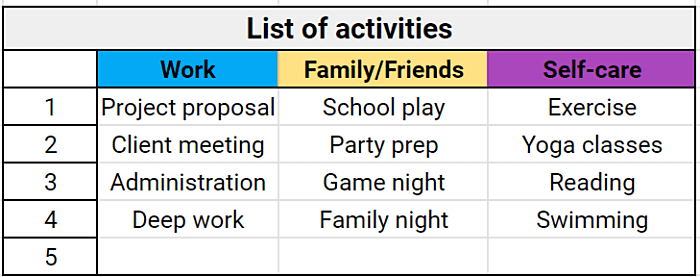
Generally speaking, there shouldn’t be too many categories in your time map. You should consider having at least three, but no more than five fields.
Now, a handy way to make your categories in the Clockify Calendar view is to add them as projects. Moreover, you can assign a particular color to each project. That way, you’ll be able to distinguish various life categories in your calendar.
Step 3: Think about your priorities
Once you have the list of key activities, it’s time to set some priorities. Instead of trying to fit in too many activities and tasks to your time map, try to be realistic. Some assignments are more significant than others.
Be sure to decide on your priorities in all categories of life. For instance, this week, you have to finish a project proposal and present it to the client. So, these are your priorities at work.
Or, your kid is participating in a school play next Wednesday, and you wouldn’t want to miss it. Write it down in your time map. Or, your sister’s planning a birthday party, and she needs your help. You wouldn’t want to let her down so be sure to add this task to your time map.
In general, when it comes to a weekly time map, you should have two or three priorities in each field. Just like with the previous step, jot down these priorities in your notebook, Excel file, or Google Sheets. As you can see below, from having four activities in each category, we selected only two or three as priorities.

Plus, once you learn how to set priorities, you’ll enhance your time management skills, as well. In fact, according to our time management guide, making sure you spend time dealing with priorities is the essence of time management.
Step 4: Start time blocking
The next step is blocking time in your calendar.
So, how to start time blocking? Here’s how you can do it:
- First, add time blocks for your priorities, making sure that you cover all categories.
- Second, if you happen to have any meetings or any other scheduled event, like a doctor’s appointment, create time blocks for these, too.
- Lastly, if there are any empty time entries left, you can include some additional tasks or activities. Alternatively, you can leave these blank time entries, to ensure that you get some rest throughout the week.
The easiest way to add time entries in the Clockify Calendar view is to click on any open time frame in the calendar. Then, you’ll see a window such as the one below, where you can write down your task/activity name, add a project, and the time you plan to do it. For instance, if you’d like to go swimming on Saturday, simply add “Swimming” as the task description. Here, a project can be a Self-care or Family/Friends category, depending on whether you plan to go with friends or alone.
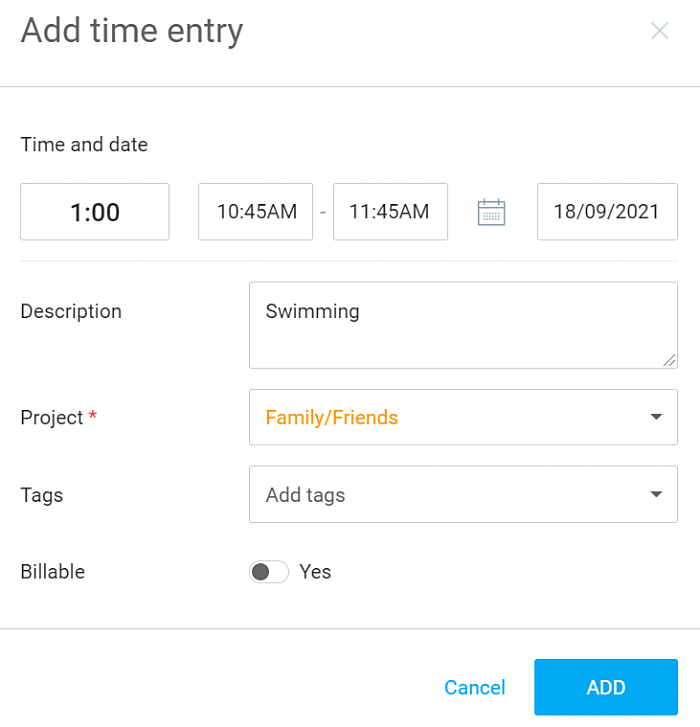
Another point worth mentioning is that you can integrate your time map in Clockify with Google Calendar or Outlook. This option comes in handy when you have many meetings throughout the week. To do so, you need to go to the Calendar view page, click on the connect icon, then choose whether you want to integrate it with Google or Outlook Calendar. Thus, all your events will be added to your Clockify Calendar — i.e., your time map. So, your map of time will include all significant meetings and calls.
Now, you may be wondering how long your time blocks should be. Well, there isn’t a one-size-fits-all answer. You can have hourly blocks, or your time blocks can last between 15 or 30 minutes. It’s crucial that your time map suits your needs and your lifestyle. For instance, if you have several work tasks per day, and each lasts around 30 minutes, then create 30-minute time blocks.
💡 If you’d like to plan your weeks, months, and even a year, check out our time blocking templates.
Step 5: Use colors to differentiate your activities
Be sure to have some fun when creating a map of time. As mentioned before, we suggest using diverse colors for each category you add.
So, when adding your tasks and activities in Clockify, you can choose a unique color for each project (life category) you add to your time map. That way, just by looking at your time map, you’ll have a better understanding of how your day will look like.
Step 6: Review your time map
Once you have filled out your time map for the following week, be sure to review it. By doing so, you’ll be able to modify some time entries if needed. For example, if you scheduled too many work tasks on Tuesday, while Thursday seems to have fewer activities, you can switch some assignments to the latter. Besides, if you notice that you left out some important family activities, such as a Saturday lunch or your mom’s birthday, now’s the perfect time to add these events to your time map.
Remember that your time map isn’t set in stone. It’s perfectly fine if you change your mind when it comes to particular activities. But, try to make these modifications before you start following a time map. Eventually, you’ll improve your time management skills and gain the ability to create time maps that perfectly suit your needs.
Furthermore, you can leave some time entries in your calendar unscheduled. For instance, if you don’t work on weekends, you don’t have to plan every hour for these two days. Instead, if you have plans with your family and friends for the weekend, you can add only these activities. Nothing better than waking up on Saturday morning knowing that you have almost an entire day free.
So, here’s an example of a time map in the Clockify Calendar view. There are three categories here:
- Business (blue color),
- Family/Friends
- and Self-care (purple color).
This map of time contains more tasks and activities on workdays, while Saturday and Sunday aren’t so over-weighted with activities.
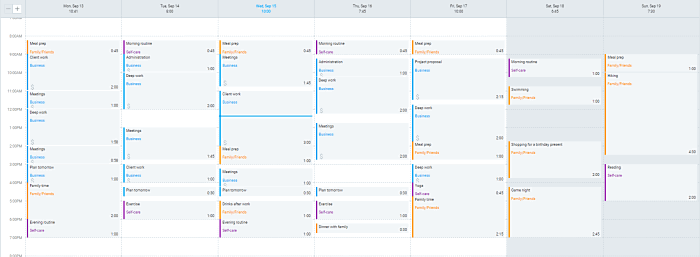
You can always add more categories if your lifestyle requires you to.
A time map template
Sometimes, you’ll be too busy to create your own time map. That’s why we made a weekly time mapping template you can use on such occasions.
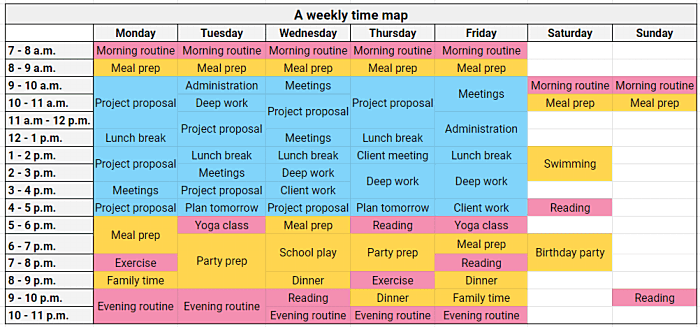
🔽 Download the Weekly Time Map Template (Google Sheets)
🔽 Download the Weekly Time Map Template (PDF)
As you can see from the screenshot above, this time map covers your weekly schedule from 7 am to 11 pm. In this example, time blocks usually last an hour, but there are several 2-hour or 3-hour time blocks as well. However, once you make a copy of our template, you’ll notice that all time blocks in the template have the same duration — an hour. The Weekly time map template contains three categories: Work, Family/Friends, and Self-care. You’re welcome to add one or two more if you want to.
You’ll also notice that there are three tabs in the template. These tabs follow the steps we described in the previous section, so there are:
- List of activities tab, which is the second step.
- List of priorities tab, the third step.
- Time blocking and adding colors tab, the fourth and fifth steps.
Besides, in the last tab, you’ll see a note regarding a time map review. So, you have a reminder to go over your map of time once again before you start using it.
Wrapping up
A time map can be an invaluable tool for organizing your professional and personal life. When mapping time, you learn more about your effectiveness and efficiency. Besides, having a time map gives you an overview of your week, so you don’t have to struggle with making decisions about what to do next. Moreover, knowing your schedule will also help you avoid any distractions. Therefore, with a time map, you’ll be able to make the best use of your time — in all areas of your life.
✉️ Have you tried mapping your time? Did you find it practical? Send your answers, suggestions, and comments to blogfeedback@clockify.me and we may include them in this or future posts.




